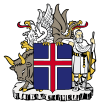- Denmark–Iceland relations
-
Danish-Icelandic relations 

Iceland
DenmarkDenmark–Iceland relations are foreign relations between Denmark and Iceland. Iceland was a part of the Kingdom of Denmark from 1814 to 1918 and a separate kingdom in a personal union with Denmark until 1944, when Iceland declared independence. Denmark has an embassy in Reykjavík. Iceland has an embassy in Copenhagen. 967 Icelanders live in Denmark.[1]
Both countries are full members of the Council of the Baltic Sea States, Nordic Council, NATO, and Council of Europe. There are around 15,000 Icelanders living in Denmark and there are around 2,800 Danes living in Iceland.[citation needed]
The relationship between Iceland and Denmark remained close after Iceland's independence, and for many years Danish was taught as a the second language in Iceland, and the Icelandic students went to Denmark for graduate studies.
Contents
History
19th century
Iceland achieved home rule in 1874, and became a fully sovereign state in 1918, united with Denmark under a common king. In 1814, following the Napoleonic Wars, Denmark-Norway was broken up into two separate kingdoms via the Treaty of Kiel. Iceland, however, remained a Danish dependency. Throughout the 19th century, the country's climate continued to grow worse, resulting in mass emigration to the New World, particularly Manitoba in Canada. About 15,000 out of a total population of 70,000 left.[2] However, a new national consciousness was revived, inspired by romantic and nationalist ideas from Continental Europe, and an Icelandic independence movement arose under the leadership of Jón Sigurðsson. In 1874, Denmark granted Iceland a constitution and limited home rule, which was expanded in 1904. The Icelanders abolished the monarchy in 1944.
20th century
Main article: Iceland during World War IIThe German occupation of Denmark on 9 April 1940 severed communications between Iceland and Denmark. As a result, on 10 April, the Parliament of Iceland, Alþingi, elected to take control of foreign affairs, electing a provisional governor, Sveinn Björnsson, who later became the republic's first president. During the first year of World War II, Iceland strictly enforced a position of neutrality, taking action against both the United Kingdom and German forces violating the laws of neutrality. On 10 May 1940, Operation Fork was launched and UK military forces began an invasion of Iceland by sailing into Reykjavík harbor. The government of Iceland issued a protest against what it called a "flagrant violation" of Icelandic neutrality. On the day of the invasion, prime minister Hermann Jónasson read a radio announcement telling Icelanders to treat the British troops with the politeness as guests.
Following a referendum on 24 May 1944, Iceland formally became an independent republic on 17 June 1944. Since Denmark was still occupied by Nazi Germany, many Danes felt offended that the step should have been taken at this time. Despite this the Danish king, Christian X, sent a message of congratulations to the Icelandic people.
See also
References
- ^ Population by origin and citizenship (Iceland)
- ^ "For Iceland, an exodus of workers". New York Times. 2008-12-05. http://www.iht.com/articles/2008/12/05/business/iceland.php. Retrieved 2010-02-10.
External links
 Foreign relations of Denmark
Foreign relations of DenmarkAfrica 
Americas Asia Afghanistan · Bangladesh · Bhutan · Burma · Cambodia · China (PRC) · India · Indonesia · Iran · Iraq · Israel · Japan · Kazakhstan · Malaysia · Nepal · North Korea · Pakistan · Palestine · Philippines · South Korea · Sri Lanka · Syria · Taiwan · Thailand · United Arab Emirates · VietnamEurope Austria · Albania · Armenia · Azerbaijan · Belarus · Belgium · Bosnia and Herzegovina · Bulgaria · Croatia · Cyprus · Czech Republic · Estonia · Finland · France · Georgia · Germany · Greece · Hungary · Iceland · Ireland · Italy · Kosovo · Latvia · Lithuania · Macedonia · Moldova · Montenegro · Netherlands · Norway · Poland · Portugal · Romania · Russia · Serbia · Slovenia · Slovakia · Spain · Sweden · Switzerland · Turkey · Ukraine · United KingdomOceania Historical Missions  Foreign relations of Iceland
Foreign relations of IcelandAmericas 
Asia India · South KoreaEurope Missions Categories:- Bilateral relations of Denmark
- Bilateral relations of Iceland
Wikimedia Foundation. 2010.
